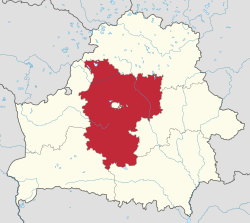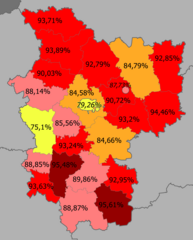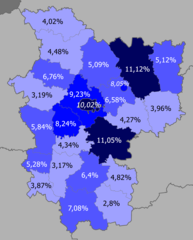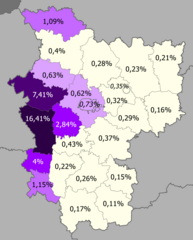|
Minsk region
Minsk region, also known as Minsk oblast[a] or Minsk voblasts,[b] is one of the six regions of Belarus. Its administrative center is Minsk, although it is a separate administrative territorial entity of Belarus. The region's population was recorded at 1,411,500 in 2011.[3] GeographyMinsk region covers a total area of 39,900 square kilometres (15,400 sq mi),[3] about 19.44% of the total area of the entire country. Lake Narach, the largest lake in the country, is located in the northern part of the region. There are four other large lakes in this region: Svir (8th largest), Myadel (11th largest), Syalyava (14th largest) and Myastro (15th largest).[4] It is the only region of Belarus whose border is not part of the international border of Belarus. History Beginning the 10th century, the territory of the current Minsk region was part of Kievan Rus', the Principality of Polotsk, and later it was included in the Grand Duchy of Lithuania. With the unification of the Grand Duchy of Lithuania and the Kingdom of Poland, the territory became part of the Polish–Lithuanian Commonwealth. In 1793, as a result of the Second Partition of Poland, the area was annexed by Russia as the Minsk region. During the collapse of the Russian Empire due to the Civil War, the western part was annexed to Poland in 1921, while the east became Soviet Belarus. The Polish National District with its capital in Dzyarzhynsk was located in the Soviet-controlled part of the current oblast in the interwar period. The Minsk region was established on 15 January 1938, based on the amendment of the Constitutional Law of the USSR. As of 20 February 1938, the area included 20 districts. Following the Soviet invasion of Poland on September 17, 1939 at the start of World War II, the former eastern lands of the Second Polish Republic were annexed in accordance with the Molotov–Ribbentrop Pact partitioning Poland and added to the Minsk region. On 20 September 1944, by the decree of the Presidium of the Supreme Soviet of the USSR, the Gressky, Kopyl, Krasnoslobodski, Luban, Slutsky, Starobin, Starodorozhski districts and the city of Sluck were removed from the Minsk region and transferred to the newly formed Bobruisk region. On 8 January 1954, by the decree of the USSR Presidium of the Supreme Soviet, the Nesvizhski and Stolbtsovsky districts from the abolished Baranovichi region, as well as the Glusk, Gressky, Kopyl, Krasnoslobodski, Luban, Slutsky, Starobin, Starodorozhski districts and the city of Sluck from the abolished Bobruisk region, were added to the Minsk region. In 1960, following the abolition of Molodechno region, its southern part became the northern part of the Minsk region. TourismThe number of travel agencies in Minsk region grew from twelve in 2000 to seventy in 2010.[5][6] The most popular tourist destinations of the region are Zaslavskoye Lake, the Zhdanovichi area which has health resorts, Nesvizh Palace and its surroundings, as well as the alpine ski resorts of Logoysk and Silichi. Administrative subdivisionsThe Minsk region comprises 22 districts (raions), 307 selsovets, 22 cities, 8 city municipalities, and 20 urban-type settlements. Districts of Minsk region
Cities and townsPopulation of cities and towns in Minsk region according to 2023 estimates:[7]
Demographics
See alsoNotes
References
External links
|
||||||||||||||||||||||||||||||||||||||||||||||||||||||||||||||||||||||||||||||||||||||||||||||||||||||||||||||||||||||||||||||||||||||||||||||||||||||||
Portal di Ensiklopedia Dunia












